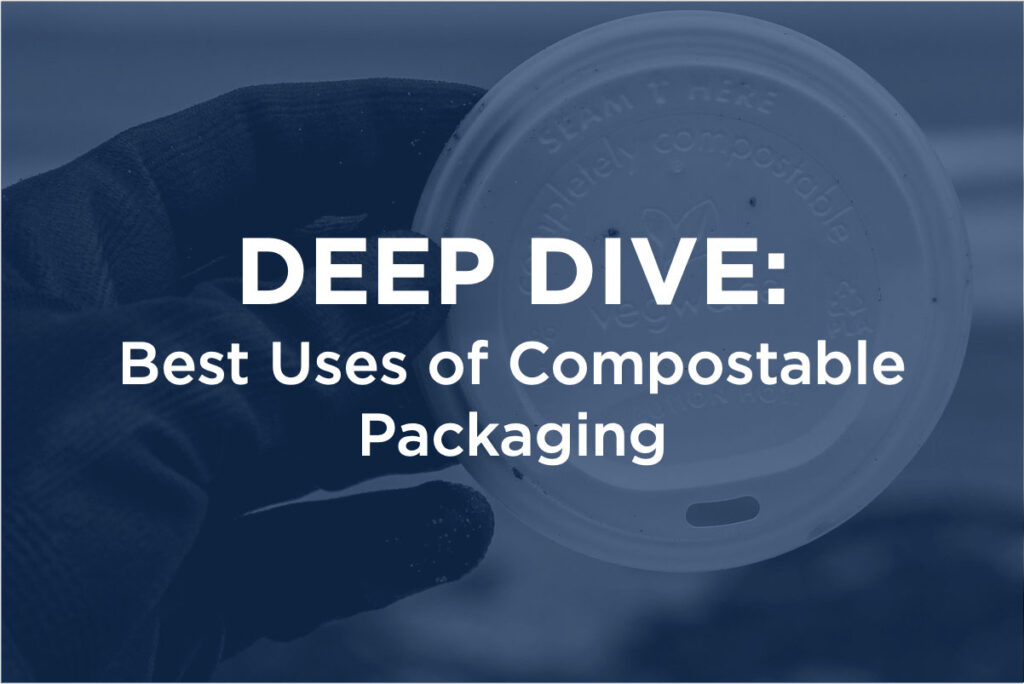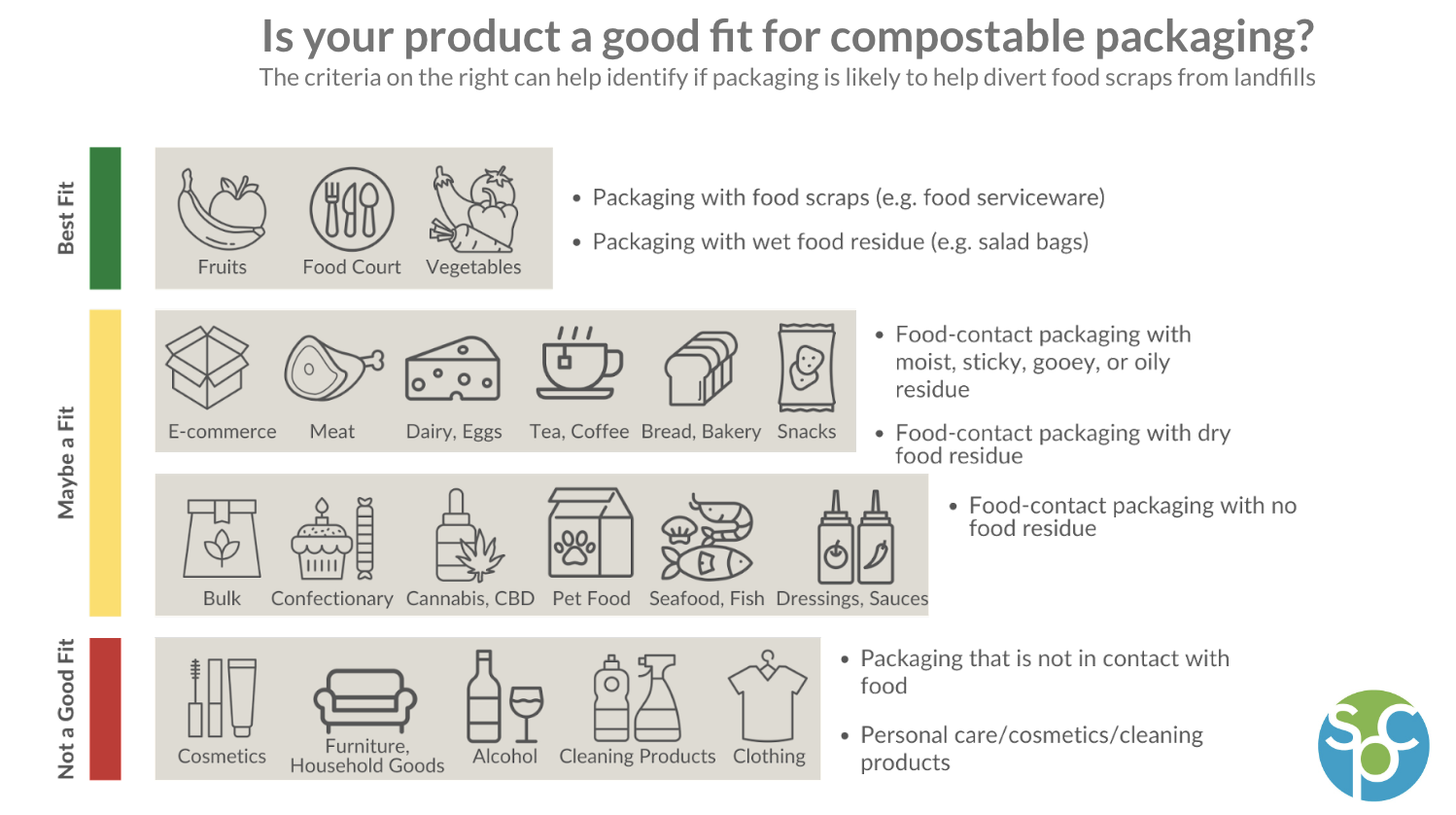Updated August 22, 2025
Originally published Jul 28, 2023
In Part 1 of this series, we discussed how the term “bioplastics” can refer to many different things, including (but not limited to) biodegradable or compostable plastics. In Part 2, we dove into the difference between “biodegradable” and “compostable,” what happens in a composting environment, and the compostability certifications. Here in Part 3 of this series, we’ll cover the appropriate uses of compostable packaging.

When does it make sense to use compostable packaging?
The primary circularity benefit of using compostable packaging is to help deliver food waste and other organic matter to composting facilities and away from landfills. Food waste in landfills is one of the top sources of waste in landfills and is also a major producer of methane, a powerful greenhouse gas that is more than 28 times as potent as carbon dioxide. Diverting food waste from landfills is a key intervention to limit climate change, and compostable packaging can help do that by being the “vehicle” that food scraps ride along with on their way to composting facilities. Composting facilities that accept compostable packaging are able to bring in more food waste than those that don’t.
Compostable packaging should be reserved for packaging that is:
- Used to serve prepared food or contains frozen or raw food
- Likely to deliver food to a composting facility
- Food-contact packaging and food service ware that is not readily recyclable
- Often disposed of with food waste (e.g., produce stickers)
- Fiber-based and is likely to become food-soiled
When should we not use compostable packaging?
Compostable packaging should not be used for the following applications, with some exceptions:
A package that can be made of easily recyclable materials
If a package can be made from a material that’s already widely recycled, that’s usually the better route. Recycling simply has more infrastructure and keeps materials working harder, longer.
Access matters. About 91% of U.S. residents can toss recyclables in the blue bin,i but only about 11% have access to composting programs that actually accept packaging.ii So if the same cup or box can be designed for recycling, it’s far more likely to avoid the landfill.
Value matters too. In a circular economy, we want to keep materials at their “highest and best use.”iii Recycling lets us do that: a PET bottle can be turned back into a PET bottle, and paper can become paper again. Composting, on the other hand, breaks things down into their basic organic parts. That’s still valuable, but it’s a one-way trip, or at least a very roundabout one—those materials can’t come back as the same product again, although the soil could theoretically be used to grow new feedstocks to make new compostable products.
That’s why recyclable should almost always beat compostable, when both are options. Compostables shine in other places—but for materials that are easily and widely recycled, recycling is the stronger play.
Packaging that is part of a suite of recyclable packaging products
Our goal is to make decisions as easy as possible for consumers when they’re discarding a suite of packaging. The ideal packaging system is either entirely recyclable or entirely compostable. If the package system has a mix of both recyclable and compostable items, it is less convenient (not to mention confusing) for consumers to separate items. For example, an e-commerce shipment that comes in a cardboard box ideally just has curbside-recyclable packaging inside so that the consumer can place all items (box, cushioning, etc.) in the recycling bin. Another example would be food service ware that’s entirely compostable. Ideally, a clamshell tray, napkins, and cutlery would all be compostable so the consumer can place everything in one bin.
Packaging not used for food, or packaging for personal care, cleaning products, or cosmetics
Packaging for non-food purposes doesn’t increase the amount of food waste diverted to composters, and thus should be used sparingly. Additionally, leftover product inside (like residues from cleaning products or cosmetics) may not be safe for compost since it will someday be soil. Some composters have raised the issue that if packaging for a lot of non-food items is designed to be compostable then they’ll receive too much packaging relative to food. The influx of compostable packaging may throw off the composters’ chemical balances at their facilities. While composters vary widely in their perspectives on and acceptance of compostable packaging, many composters who accept packaging note that they ultimately want mostly food and yard trimmings and just some packaging.

Moving towards food-contact materials
As we’ve explained in this series, the most appropriate use of compostable packaging is in food-contact applications to divert food scraps to composting facilities. That said, engineering high-performance compostable materials for food-contact applications is challenging, and we aren’t there yet. While it sounds simple to use a compostable film, for example, to package raw chicken, the performance requirements are steep for most food-contact applications: moisture and oxygen barriers, shelf life requirements, grease barriers, and more create an engineering challenge that few have solved, much less at a price point the market is willing to tolerate.
To keep R&D moving and build the scale needed to bring costs down, we’re thoughtfully exploring select lower-performance, non-food applications, like our Sway seaweed-based polybags. We believe non-food pilots can help us learn and scale, without losing sight of the main goal of composting and compostable packaging.
Sway is a compostable replacement for thin-film flexible plastics made with seaweed. We are currently developing Sway for lower-risk, lower-performance uses like protective poly bags for apparel, home goods, accessories, cosmetics, and personal care items. Trials like these help us improve compatibility with manufacturing processes, validate end-of-life pathways, and generate informative data, all of which accelerate progress toward food-grade films. Simultaneously, we’ll be working with material scientists and packaging engineers to improve the barrier properties of Sway films so that they could be used for all kinds of food-contact applications. Until then, we’ll keep development targeted and responsible, and we’ll steer customers to recyclable formats when that’s the better choice.
I have a good use case for compostable packaging. What else should I know?
Compostable packaging should be certified by one of the below bodies or tests:
- BPI Compostable – used for compostable foodservice packaging
- TUV Austria OK Compost (either “HOME” or “INDUSTRIAL”)
- ASTM D6400 or ASTM D6868 (more common in the U.S.)
- EN 13432 (more common in Europe)
For more information on compostability certifications, check out the previous Deep Dive in this series!
Compostable packaging should be clearly marked to prevent contamination.
Compostable packaging only turns to compost if it’s composted. Compostable packaging should be marked clearly to instruct consumers to find an outlet to compost it. It should also include any applicable certifications on the package. Signals and wording of compostability also help composters spot compostable packaging and avoid contamination from non-compostable packaging. Best practices include tinting the packaging or food service ware green and displaying the compostability language in large text.
Endnotes
i Sustainable Packaging Coalition, “2020-2021 Centralized Study on Availability of Recycling.” This number represents the “US residents [who] have access to either curbside and/or drop-off recycling programs that accept packaging materials.”
ii Sustainable Packaging Coalition (2021), “Understanding the Role of Compostable Packaging in North America.”
iii For more information, see the Ellen MacArthur Foundation’s page on this principle: https://ellenmacarthurfoundation.org/circulate-products-and-materials
___________
Where to go from here?
- Visit our library of all our Deep Dives articles here
- Check out our Sustainability Terms Glossary, where we’ll add key terms from each of our Deep Dives over time.
- Sign up for our Deep Dive LinkedIn Newsletter and get these articles delivered straight to your inbox every month.
- Bookmark these pages for future reference!
